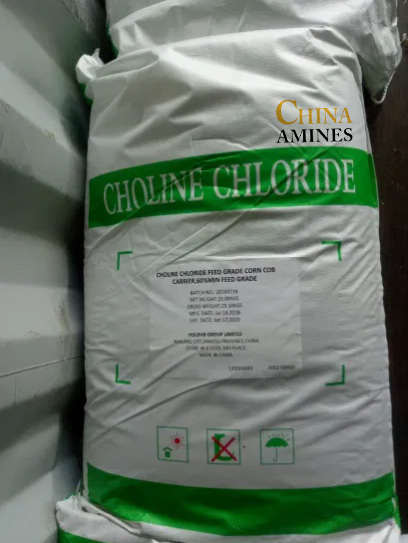1. Chemical Structure and Properties
Active Component: Choline Chloride (C₅H₁₄ClNO)
Structural Formula: [HOCH₂CH₂N⁺(CH₃)₃]Cl⁻ (quaternary ammonium salt)
Carrier Material: Food/feed-grade Silica (SiO₂)
Composition: 60% choline chloride adsorbed onto 40% porous silica granules
Physical Properties:
Appearance: White to off-white free-flowing granules
Particle Size: 0.5–2 mm; Bulk Density: ~0.5–0.6 g/cm³
Moisture Content: <3% (w/w); silica minimizes moisture absorption
Solubility: Choline chloride dissolves in water; silica is insoluble but disperses well
Key Features:
- Excellent flowability due to spherical silica morphology
- Anti-caking: silica provides moisture-buffering effect in humid storage conditions
2. Industrial Applications
Animal Feed:
- Application: Prevents fatty liver syndrome; enhances egg production in layers and growth in swine
- Dosage: 600–1,200 g/ton feed (per NRC guidelines)
- Compatibility: Works well in premix and pelleted formulations
Advantages Over Other Carriers:
- Superior flowability and dust control
- Improved blend uniformity in automatic batching systems
Pharmaceuticals:
- Excipient: Controlled release matrix for choline-based supplements
3. Safety and Toxicology
Choline Chloride:
- Oral Toxicity: Low (LD50 rat: >5,000 mg/kg); practically non-toxic (Category 5)
- Dermal/Eye Contact: Mild irritation only
Silica Carrier:
- Type: Amorphous (non-crystalline) silica, feed-grade, FDA GRAS
- Inhalation Risk: May irritate respiratory tract if dust is inhaled (OSHA PEL: 15 mg/m³)
Handling Precautions:
- PPE: Use dust masks (N95), nitrile gloves, and protective eyewear
- Storage: Keep in dry, ventilated area to maintain granule integrity
4. Environmental and Regulatory Compliance
Environmental Impact:
- Biodegradability: Choline chloride readily biodegradable; silica is inert and persistent
- Aquatic Toxicity: LC50 (fish, 96h): >100 mg/L; no significant aquatic hazard
Soil Degradation:
- Choline metabolizes into betaine, then CO₂ and water; silica remains as a stable mineral
Regulatory Frameworks:
- China: GB/T 23735–2021 feed-grade compliant
- USA: FDA GRAS (21 CFR 582.5250); silica permitted under 21 CFR 172.480
- EU: Approved as E 3.1.1 per Feed Additive Regulation (EC 1831/2003); REACH-registered silica (CAS 112945-52-5)
Transport: Non-hazardous; no UN classification
5. Case Studies and Application Insights
Case 1: Layer Hen Productivity (USA, 2023)
- Usage: 1,000 g/ton feed of 60% silica choline chloride
- Outcome: +8% egg yield; -20% liver fat accumulation
- Benefit: $0.8/ton feed savings vs. liquid formulation due to reduced handling loss
Case 2: Swine Premix in High-Humidity Regions (Thailand, 2022)
- Challenge: Feed caking and segregation
- Solution: Switch to silica-carrier choline
- Results: 30% fewer caking events; 5% higher feed intake after prolonged storage
Comparative Analysis:
- Pros: Exceptional flowability, dust suppression, moisture tolerance
- Cons: Non-biodegradable; lacks circular economy advantage of corn cob carriers


